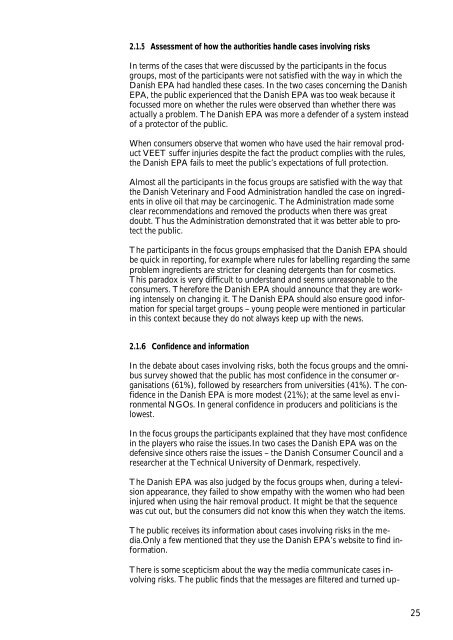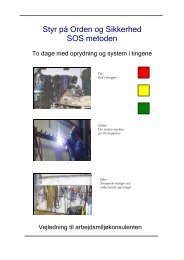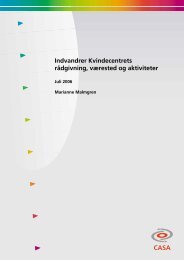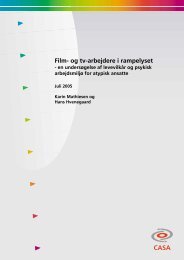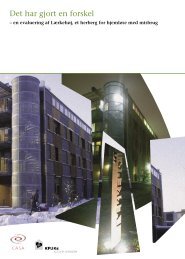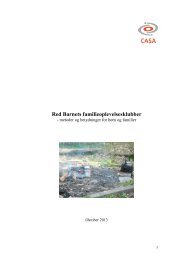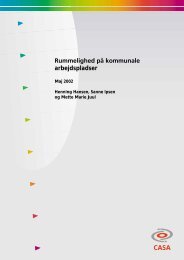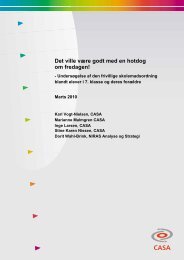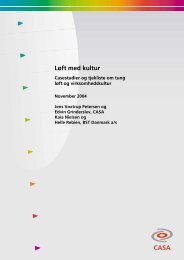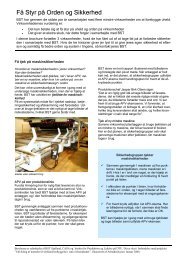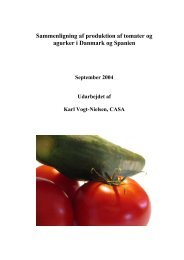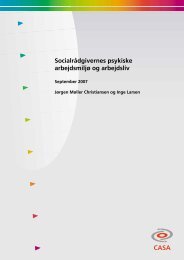Download rapport - Center for Alternativ Samfundsanalyse
Download rapport - Center for Alternativ Samfundsanalyse
Download rapport - Center for Alternativ Samfundsanalyse
Create successful ePaper yourself
Turn your PDF publications into a flip-book with our unique Google optimized e-Paper software.
2.1.5 Assessment of how the authorities handle cases involving risksIn terms of the cases that were discussed by the participants in the focusgroups, most of the participants were not satisfied with the way in which theDanish EPA had handled these cases. In the two cases concerning the DanishEPA, the public experienced that the Danish EPA was too weak because itfocussed more on whether the rules were observed than whether there wasactually a problem. The Danish EPA was more a defender of a system insteadof a protector of the public.When consumers observe that women who have used the hair removal productVEET suffer injuries despite the fact the product complies with the rules,the Danish EPA fails to meet the public’s expectations of full protection.Almost all the participants in the focus groups are satisfied with the way thatthe Danish Veterinary and Food Administration handled the case on ingredientsin olive oil that may be carcinogenic. The Administration made someclear recommendations and removed the products when there was greatdoubt. Thus the Administration demonstrated that it was better able to protectthe public.The participants in the focus groups emphasised that the Danish EPA shouldbe quick in reporting, <strong>for</strong> example where rules <strong>for</strong> labelling regarding the sameproblem ingredients are stricter <strong>for</strong> cleaning detergents than <strong>for</strong> cosmetics.This paradox is very difficult to understand and seems unreasonable to theconsumers. There<strong>for</strong>e the Danish EPA should announce that they are workingintensely on changing it. The Danish EPA should also ensure good in<strong>for</strong>mation<strong>for</strong> special target groups – young people were mentioned in particularin this context because they do not always keep up with the news.2.1.6 Confidence and in<strong>for</strong>mationIn the debate about cases involving risks, both the focus groups and the omnibussurvey showed that the public has most confidence in the consumer organisations(61%), followed by researchers from universities (41%). The confidencein the Danish EPA is more modest (21%); at the same level as environmentalNGOs. In general confidence in producers and politicians is thelowest.In the focus groups the participants explained that they have most confidencein the players who raise the issues.In two cases the Danish EPA was on thedefensive since others raise the issues – the Danish Consumer Council and aresearcher at the Technical University of Denmark, respectively.The Danish EPA was also judged by the focus groups when, during a televisionappearance, they failed to show empathy with the women who had beeninjured when using the hair removal product. It might be that the sequencewas cut out, but the consumers did not know this when they watch the items.The public receives its in<strong>for</strong>mation about cases involving risks in the media.Onlya few mentioned that they use the Danish EPA’s website to find in<strong>for</strong>mation.There is some scepticism about the way the media communicate cases involvingrisks. The public finds that the messages are filtered and turned up-25


